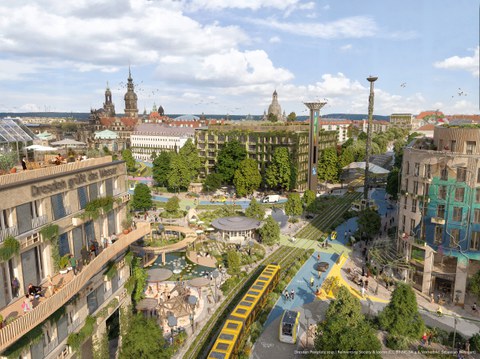Jan 07, 2025
A vision for the future of Dresden's Postplatz 2045

Dresden Postplatz 2045
What could Postplatz look like in the future? A new graphic vision shows a surprisingly green and lively perspective for this central traffic junction. Instead of appearing as a "stone joint" as before, the picture shows the square being transformed into an oasis of green and blue: green roofs and façades, unsealed open spaces and water areas as well as a large number of new trees give it the atmosphere of a park and thus a completely new quality of stay.
Behind this vision are civil society stakeholders such as BUND Dresden and the Local Agenda Dresden, together with scientists from the TUD Dresden University of Technology (TUD) and the Leibniz Institute of Ecological Urban and Regional Development (IÖR). The Reinventing Society association and the loomn agency implemented the ideas graphically. "With this positive vision, we want to inspire people to become active themselves and take part in shaping a liveable city of the future," explains Julia Leuterer from the Local Agenda.
Hanna Witte from the "Biodiverse Sponge City Dresden" project makes it clear that such green visions are urgently needed: "Sealed squares like Postplatz become a health hazard in hot summers, especially for older people and children." Measurements and simulations by Dr. Astrid Ziemann from the Chair of Meteorology at the TUD show that extensive greening can significantly reduce thermal pollution. Astrid Ziemann adds: "Vital vegetation is the best answer that cities can give to heat, both for open spaces and for tolerable temperatures in buildings." At the same time, such green oases provide a habitat for animals and improve the resilience of plants in dry periods through sustainable rainwater management.
Dr. Christoph Schünemann from the Leibniz Institute of Ecological Urban and Regional Development emphasizes: "This image has no specific planning claim - it is an invitation to think things differently." The illustration should therefore not be seen as a blueprint for planning, but rather as a motivating guide - for a Dresden that faces up to the challenges of climate change. "However, the ideas that we have brought together in the vision of the future are well-founded, because we as the scientists involved have been able to contribute key findings from our research into heat adaptation in cities," concludes Christoph Schünemann.
The image is available under a Creative Commons license so that it can be used by anyone who is committed to a climate-friendly and inclusive Dresden:
https://tu-dresden.de/bu/umwelt/hydro/ihm/meteorologie/forschung/forschungsprojekte/dresden-postplatz-2045-ein-zukunftsbild
The project was financed by the BUND project "Biodiverse Sponge City Dresden", Stadtentwässerung Dresden and Lokale Agenda Dresden.
Press contact:
TU Dresden
Press Office
Phone: +49 (0) 351 463 32398
E-mail
